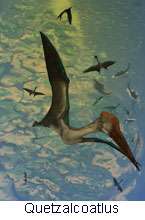Prehistoric winged beasts 'pole-vaulted' into flight (w/ Video)

(PhysOrg.com) -- Controversial claims that enormous prehistoric winged beasts could not fly have been refuted by the most comprehensive study to date which asserts that giant pterosaurs were skilled in flight.
The study, by Dr. Mark Witton from the University of Portsmouth and Dr Michael Habib from Chatham University USA, contradicts recent assertions that the creatures were flightless and explains how they took to the air.
They state that the giant reptiles took off by using all four of their limbs and effectively ‘pole-vaulting’ over their wings using their leg muscles and pushing from the ground using their powerful arm muscles. Once airborne they could fly huge distances and even cross continents. Their research is published today in the international Public Library of Science journal, PLoS ONE.
The debate about whether extinct giant pterosaurs, the largest of which were the height of giraffes, could fly has divided palaeontologists in recent years. Previous suggestions that they were flightless were based on assumptions that they were too heavy or because they would have taken off like birds, by running or leaping into their air using just their hind limbs.
Dr Witton said: “Most birds take off either by running to pick up speed and jumping into the air before flapping wildly, or if they’re small enough, they may simply launch themselves into the air from a standstill. Previous theories suggested that giant pterosaurs were too big and heavy to perform either of these manoeuvres and therefore they would have remained on the ground.
“But when examining pterosaurs the bird analogy can be stretched too far. These creatures were not birds; they were flying reptiles with a distinctly different skeletal structure, wing proportions and muscle mass. They would have achieved flight in a completely different way to birds and would have had a lower angle of take off and initial flight trajectory. The anatomy of these creatures is unique.”
Drs Witton and Habib suggest that, with up to 50 kgs of forelimb muscle, the creatures could easily have launched themselves into the air despite their massive size and weight.
Dr Witton, from the School of Earth and Environmental Science, said: “The size of the flight muscles in a giant pterosaur would be incredible: they alone would be up to 50 kgs and account for 20 per cent of the animal’s total mass providing tremendous power and lift.
Dr. Habib added: “Scientists have struggled for decades to figure out how giant pterosaurs could become airborne and some recent proposals have simply assumed it must have been impossible. But they may have approached the problem from the wrong end: instead of taking off with their legs alone, like birds, pterosaurs probably took off using all four of their limbs. By using their arms as the main engines for launching instead of their legs, they use the flight muscles – the strongest in their bodies – to takeoff and that gives them potential to launch much greater weight into the air. This may explain how pterosaurs became so much larger than any other flying animals known.”
Some scientists have argued that these animals were too heavy to achieve flight but the new study asserts that the animals were slightly smaller and lighter than previous theories have assumed which changes the entire premise.
Previous theories have asserted that giant pterosaurs could have been six metres tall with a wingspan of up to 12 metres but Dr Witton and Mr Habib argue that five metres high with a 10 meter wingspan would have been more realistic.
“Weight estimates based on a 12 metre wingspan will be almost twice that based on 10 metres so an accurate assessment is vital,” Dr Witton said.
The researchers examined every possible anatomical aspect of the prehistoric flying reptiles, which died out 65 million years ago along with the dinosaurs. Using fossilised remains they estimated size and weight and calculated bone strength and mechanics and potential ‘flap gliding’ performance.
They concluded that not only could pterosaurs fly, they could do so extremely well and could have travelled huge distances and even crossed continents. It’s unlikely that they would need to flap continuously to remain aloft but would flap powerfully in short bursts with their large size allowing them to achieve rapid cruising speeds.
Dr Witton said: “Pterosaurs had incredibly strong skeletons: for their weight, they’re probably amongst the strongest ever evolved. And unlike birds, where the wings become relatively weak as they grow in size, those of pterosaurs do the opposite: they become stronger. As pterosaurs became larger, they reinforced their wings and expanded their flight muscles to ensure they could keep flying.”
“One of the reasons why pterosaur research is so tricky is that there is very little in the way of fossilised remains. We’re working with extremely small number of fossil specimens. You could take all the giant pterosaur fossils in the world and fit them on to a coffee table,” Dr Witton said.
Dr Witton said: “All the direct data we have on pterosaurs, even the largest, suggests they were capable of flying.
“And after almost a century in the doldrums, we're starting to see far more progressive research on pterosaurs. It’s not quite a revolution but we're certainly going through something of a renaissance.”
Provided by University of Portsmouth



















